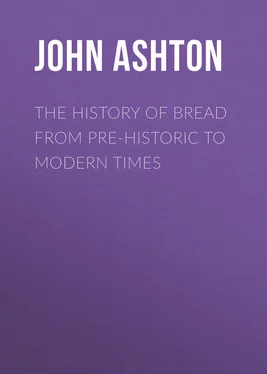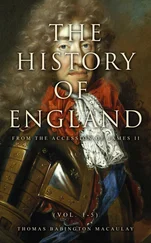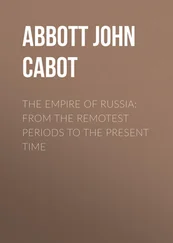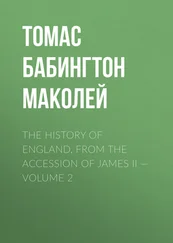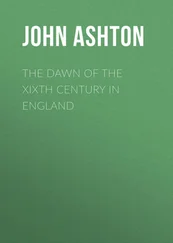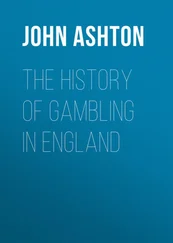John Ashton - The History of Bread From Pre-historic to Modern Times
Здесь есть возможность читать онлайн «John Ashton - The History of Bread From Pre-historic to Modern Times» — ознакомительный отрывок электронной книги совершенно бесплатно, а после прочтения отрывка купить полную версию. В некоторых случаях можно слушать аудио, скачать через торрент в формате fb2 и присутствует краткое содержание. Жанр: foreign_antique, foreign_prose, на английском языке. Описание произведения, (предисловие) а так же отзывы посетителей доступны на портале библиотеки ЛибКат.
- Название:The History of Bread From Pre-historic to Modern Times
- Автор:
- Жанр:
- Год:неизвестен
- ISBN:нет данных
- Рейтинг книги:3 / 5. Голосов: 1
-
Избранное:Добавить в избранное
- Отзывы:
-
Ваша оценка:
- 60
- 1
- 2
- 3
- 4
- 5
The History of Bread From Pre-historic to Modern Times: краткое содержание, описание и аннотация
Предлагаем к чтению аннотацию, описание, краткое содержание или предисловие (зависит от того, что написал сам автор книги «The History of Bread From Pre-historic to Modern Times»). Если вы не нашли необходимую информацию о книге — напишите в комментариях, мы постараемся отыскать её.
The History of Bread From Pre-historic to Modern Times — читать онлайн ознакомительный отрывок
Ниже представлен текст книги, разбитый по страницам. Система сохранения места последней прочитанной страницы, позволяет с удобством читать онлайн бесплатно книгу «The History of Bread From Pre-historic to Modern Times», без необходимости каждый раз заново искать на чём Вы остановились. Поставьте закладку, и сможете в любой момент перейти на страницу, на которой закончили чтение.
Интервал:
Закладка:
This, at all events, seems to have been the shape in vogue about the time of the Christian era; but in the bas reliefs on the tomb of Eurysaces, who was a baker in a large way of business at Rome, they seem to be globular. These bas reliefs are most interesting, as they show the whole history of baking. First there is the purchase of the corn, and payment being made for it; then we see it ground, and sifted to separate the bran. Next a man is buying some flour. Then we see the dough being kneaded by horse-power, the bakers making it into loaves, the baker with his peel baking the loaves, which are afterwards carried in paniers to be weighed. Then there are the customers, and the bread being sent out for delivery.
Pliny tells us that there were no bakers at Rome until the war with King Perseus of Macedon, more than 580 years after the building of the city. The ancient Romans used to make their own bread, it being an occupation which belonged to the women, as we see is the case in many nations even at the present day. In those times they had no cooks in the number of their slaves, but used to hire them for the occasion from the market. The Gauls were the first to employ the bolter that is made of horse-hair; while the people of Spain made their sieves and meal dressers of flax, and the Egyptians of papyrus and rushes.
Many freedmen were engaged as bakers, and under the Republic it was one of the duties of the œdiles to see that the bread was properly prepared and correct in weight. Grain was delivered into public granaries by enrolled Saccarii , and it was distributed to the bakers by a corporation called the Catabolenses . A bakers’ guild ( corpus or collegium pistorum ), which long existed, was organised by Trajan, and this body, through its connection with the cura amonæ , became of much importance, and enjoyed various privileges. There were guilds of pistores and clibanarii at Pompeii. A great increase in the number of bakeries ( pistrinæ , officinæ pistoriæ ) afterwards took place at Rome, owing, probably, to the action of Aurelian in introducing a daily distribution of bread, instead of the old monthly distribution of grain that had been usual since the time of Gracchi.
CHAPTER V
BREAD IN EASTERN LANDS
Agriculture has always taken a prominent part in Chinese polity, and is incorporated in their religious observances; and a deep veneration for it is inscribed on all the institutions in China. Among the several grades of society the cultivators of mind rank first, then those of land, third come the manufacturers, and lastly the merchants. Homage to agriculture is done annually by the Emperor, who makes a show of performing its operations.
This ceremony, which originated more than 2000 years ago, had been discontinued by degenerate princes, but was revived by Yong-tching, the third of the Mantchoo dynasty. This anniversary takes place on the 24th day of the second moon, coinciding with our month of February. The monarch prepares himself for it by fasting three days; he then repairs to the appointed spot with three princes, nine presidents of the high tribunals, forty old and forty young husbandmen. Having performed a preliminary sacrifice of the fruits of the earth to Shang-ti, the supreme deity, he takes in his hand the plough, and makes a furrow of some length, in which he is followed by the princes and other grandees. A similar course is observed in sowing the field, and the operations are completed by the husbandmen.
An annual festival in honour of Agriculture is also celebrated in the capital of each province. The governor marches forth, crowned with flowers, and accompanied by a numerous train, bearing flags adorned with agricultural emblems and portraits of eminent husbandmen, while the streets are decorated with lanterns and triumphal arches.
Although rice is the staple grain in use in China, wheat-growing is one of the principal industries in the northern and middle parts of that country. The winter wheat is planted at about the same time that wheat is planted here. The soil, especially in the northern provinces, is so well worn that it is unfitted for wheat-growing, and the Chinese farmers, appreciating this fact, and the fact that all kinds of fertilisers are excessively dear, make the least money do the most good by mixing the seed with finely-prepared manure.
A man with a basket swung upon his shoulders follows the plough, and plants the mixture in large handsful in the furrows, so that when the crop grows up it looks like young celery. Immediately after the first melting of snow, and when the ground has become sufficiently hardened by frost, these wheat-fields are turned into pastures, under the theory that, by a timely clipping of the tops of these plants, the crops will grow up with additional strength in the spring.
Wheat-threshing is the principal interest in Chinese farming. Owing to the scarcity of fuel, the wheat is usually pulled up by the root, bundled in sheaves, and carted to the mien-chong , a smooth and hardened space of ground near the home of the farmer. The top of the sheaves is then clipped off by a hand machine. The wheat is then left in the mien-chong to dry, whilst the headless sheaves are piled in a heap for fuel or thatching. When the wheat is thoroughly dry it is beaten under a great stone roller pulled by horses, while the places thus rolled are constantly tossed over with pitchforks. The stalks left untouched by the roller are threshed with flails by women and boys. The beaten stalks and straws are then taken out by an ingenious arrangement of pitchforks, and the chaff is removed by a systematic tossing of the grain into the air until the wind blows every particle of chaff or dust out of the wheat. Even the chaff is carefully swept up and stowed away for fuel or other useful purposes, such as stuffing mattresses or pillows. After the wheat is allowed to dry for a few hours in the burning sun, it is stowed away in airy bamboo bins.
The milling process is a very ancient one. Two large round bluestone wheels, with grooves neatly cut in the faces on one side, and in the centre of the lower wheel a solid wooden plug is used. The process of making flour out of wheat by this machinery is called mob-mien . Usually a horse or mule is employed; the poor, having no animals, grind the grain themselves.
Three distinct qualities of flour are thus produced. The shon-mien , or A grade, is the first siftings; the nee-mien , or second grade, is the grindings of the rough leavings from the first siftings, which is of a darker and redder colour than the first grade; and mod is the finely-ground last siftings of all grades. When bread is made from this grade it resembles rough gingerbread. This is usually the food of the poorest families. The bread of the Chinese is usually fermented, and then steamed. Only a very small quantity is baked in ovens. But the staple articles of food in Northern China are wheat, millet, and sweet potatoes. Wheat and rice are the food of the rich, while the middle classes of the Empire eat millet and rice. In the southern provinces the entire bread-stuff is rice.
At King-Kiang wheat is served as rice. It is first threshed with flails made of bamboo, and then pounded by a rough stone hammer, working in a mortar which rests on a pivot, and is operated like a treadle by the human foot. This separates the husks, and it is then winnowed, the grain being afterwards ground in the usual way.
Rice is undoubtedly the staple food of those parts of China where it will grow, in spite of its being a precarious crop, the failure of which means famine. A drought in its early stages withers it, and an inundation, when nearly ripe, is equally destructive; whilst the birds and locusts, which are fearfully numerous in China, infest it more than any other grain. Rice requires not only intense heat, but moisture so abundant that the field in which it grows must be repeatedly laid under water. These requisites exist only in the districts south of the Yang-tse Kiang (the Yellow River) and its several tributaries. Here a vast extent of land is perfectly fitted for this valuable crop. Confined by powerful dykes, these rivers do not generally, like the Nile, overflow and cover the country; but by means of canals their waters are so widely distributed that almost every farmer, when he pleases, can inundate his field. This supplies not only moisture, but a fertilising mud or slime, washed down from the distant mountains. The cultivator thus dispenses with manure, of which he labours under a great scarcity, and considers it enough if the grain be steeped in liquid manure.
Читать дальшеИнтервал:
Закладка:
Похожие книги на «The History of Bread From Pre-historic to Modern Times»
Представляем Вашему вниманию похожие книги на «The History of Bread From Pre-historic to Modern Times» списком для выбора. Мы отобрали схожую по названию и смыслу литературу в надежде предоставить читателям больше вариантов отыскать новые, интересные, ещё непрочитанные произведения.
Обсуждение, отзывы о книге «The History of Bread From Pre-historic to Modern Times» и просто собственные мнения читателей. Оставьте ваши комментарии, напишите, что Вы думаете о произведении, его смысле или главных героях. Укажите что конкретно понравилось, а что нет, и почему Вы так считаете.
